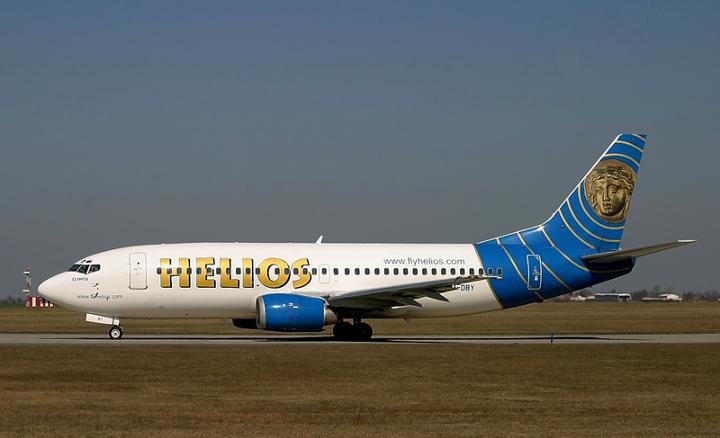There’s precious little certainty about what happened to Malaysia Airlines Flight 370 after it left the ground in Kuala Lumpur, but as the Washington Post reported this morning, there’s “a new consensus among investigators” that the plane flew a steady route across a little-traveled corridor of the Indian Ocean before running out of fuel and crashing. Once the plane is found — thanks to satellite flight-path analysis, investigators have an idea of where to look — the investigation will turn to why the plane flew on autopilot until it couldn’t fly anymore.
A lot of what we know supports the theory that MH370 was a ghost plane — specifically, that a fire or depressurization or some other catastrophic event forced the pilot to attempt an emergency landing, which would explain the mysterious westward turn made by the Boeing 777. Before the landing could be executed, the theory goes, the crew was incapacitated, leaving a plane full of dead and dying people that flew itself west over the Indian Ocean until it ran out of fuel and dropped from the sky.
It wouldn’t be the first time such an event has brought down an aircraft. The stories of five previous ghost planes shed light on what might have happened here.
1. Helios Airways Flight 522
Human error was the root of this terrifying 2005 ghost flight that crashed outside of Athens and killed all 121 people onboard. The problem with this 737 began when ground crew set the plane’s pressurization system to manual to check a reported leak. The system was never switched back to auto. Investigations after the crash showed that the flight crew had several opportunities to notice and correct the setting, but they never did. Instead, pressure started dropping 13 minutes into the Cyprus-to-Prague flight. Alarms sounded onboard but the pilots, beginning to feel the effects of hypoxia, misinterpreted them. Even after oxygen masks dropped to passengers, the plane continued its climb. Unresponsive to radio communication, the jet flew into Greek airspace, where two F-16s intercepted it. The pilots saw a grim scene. The 737’s pilots were slumped over their controls and passengers were wearing oxygen masks. A moment of hope emerged when a flight attendant, still conscious after using several crew oxygen containers, made his way into the cockpit and took the plane’s controls. But he was too late. The plane was out of gas and it crashed into a mountain outside of Athens. Investigations said the passengers were alive but unconscious at the time of the crash, though some Greek officials believe many passengers froze to death during the flight.

2. Payne Stewart’s Learjet
Two crew members and four passengers, including 45-year-old golfer Payne Stewart, died in a ghost plane incident that ended in a field outside Aberdeen, South Dakota. The jet took off from Northwest Florida on its way to Dallas, and trouble struck quickly with the first unacknowledged contact coming 14 minutes after departure. Fighter jets were soon dispatched to determine a problem. All they saw were dark windows, opaque with ice. After the plane crashed, killing all six people aboard, the NTSB said, “The probable cause of this accident was incapacitation of the flight crew members as a result of their failure to receive supplemental oxygen following a loss of cabin pressurization, for undetermined reasons.” Even when a ghost flight is watched on its way to inevitable demise, the basic mystery of what went wrong often remains intact.
3. Australian Mine Workers
In September 2000, a chartered twin-propeller plane left Perth on its way to a mining town almost 400 miles away. But about 30 minutes into an uneventful flight, the plane began to climb too high. When air-traffic controllers asked the pilot what was wrong, he answered in slurred speech and then silence. Minutes later, the microphone cut off, and for the next five hours, the plane cruised across Australia, its passengers unconscious from a lack of pressure in the cabin. It eventually crashed almost 1,900 miles away in the country’s Northwest.
4. Bo Rein Crash
Six weeks after LSU hired him to coach its football team, Bo Rein died after riding a ghost plane into the Atlantic Ocean, never coaching a game in Death Valley. What was supposed to be a 40-minute flight onboard a Cessna twin-turboprop turned deadly when the pilot re-routed to avoid a thunderstorm. After reaching 23,000 feet, the plane lost contact with air-traffic controllers and kept climbing, settling in at 41,000 feet, well above its maximum flying height. A thousand miles later, the plane spiraled into 1,100 feet of water off the Virginia coast. Though investigators only found minimal wreckage and no human remains, they later said the plane’s pilot lost consciousness after presumable depressurization.
5. Gulf of Mexico crash
Dr. Peter Hertzak left Slidell, Louisiana, at 6:43 in the morning in April 2012, on his way to Sarasota, Florida. He’d never arrive. Trouble first arose when the FAA noticed the plane flying in circles over the Gulf of Mexico. When Hertzak didn’t respond to radio communications, two F-15s were dispatched to the Cessna’s location. The jet pilots saw an unresponsive pilot and an iced-over windshield, indicating cabin depressurization. After two hours of circling, the plane started to descend before it landed softly on the water and sank. Though his body was never found, Hertzak was presumed dead. In the days after the crash, reporters revealed that he had recently been banned from performing practice surgery, leading some to speculate about suicide.
